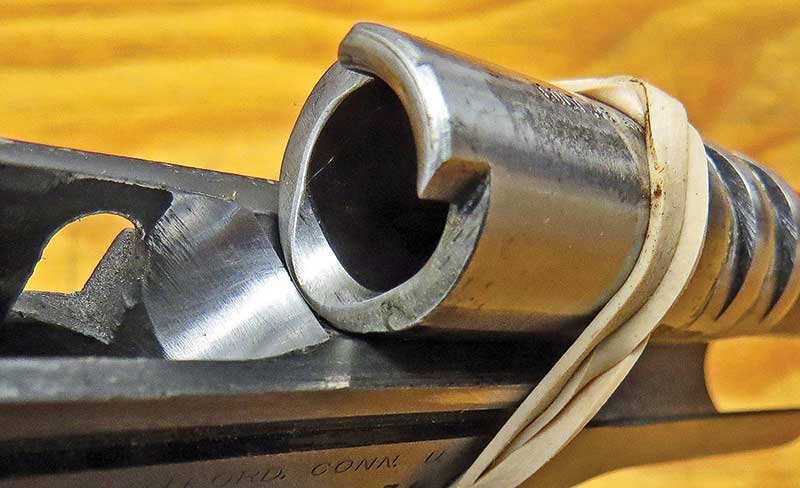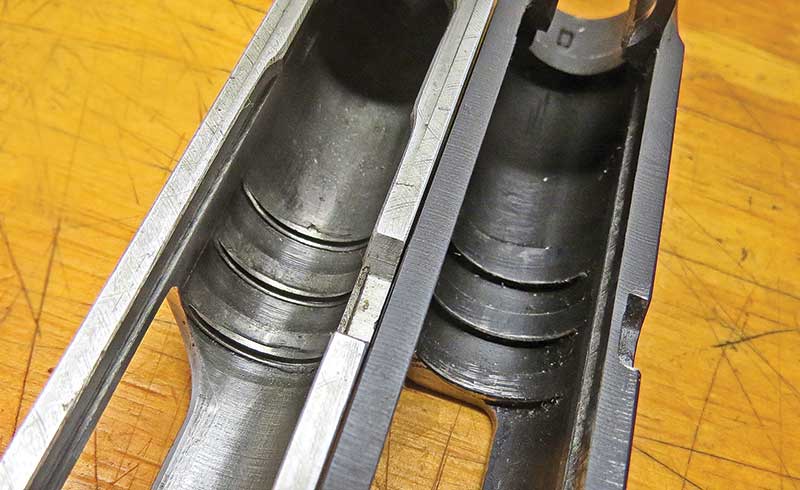Caveat Emptor
With a seemingly ample supply of used guns available (many sold to fund new gun purchases), used gun prices are climbing to new highs. Higher prices for used guns means we can’t afford to make unnecessary mistakes when we buy. Let’s face it, a used gun is a gamble, some more than others. Sometimes, even after a good inspection, we get surprised, and repairs are in order, so the “buyer beware” warning is in effect here.
Most of the problems we inherit will be minor, but there are a few potential issues which can prove costly. As commonplace as the 1911 platform is, there are still some anomalies we need to look out for in stock factory guns, as well as guns which may have been modified.
Many ’70’s vintage Colts had slide locking lug recesses which were, in some cases, horribly wrong. They were improperly spaced, off-center to the slide bore, too shallow or just inexplicably rounded off on their corners. While many flaws can be corrected, these typically cannot. Their fix is a replacement slide, especially if you’re considering a barrel upgrade.
Issues with off-center magazine wells and poorly cut trigger tracks can be addressed, but they involve some painstaking work. Sometimes even when we pre-inspect carefully, problems arise after the purchase. Fortunately, a wealth of information and the tools and parts to effect repairs are at our fingertips. Brownells’ videos, tech support and their extensive supply of factory stock and custom replacement parts will generally save the day unless something serious pops up. Here are a few common sense things to look out for, and some fixes for them.
Tough Repairs
First, a gun having been tinkered with is not necessarily the kiss of death. Most random acts of customization can be undone or redone, but there are a few time-period modifications to avoid. In the ’80’s and early ’90’s, Millett sights offered a new system of attaching front sights to autos called the “Dual Crimp.” This system allowed the average shooter, fledgeling gunplumber, or gunshop owner a way to upgrade sight systems without needing a lot of expensive machinery. Millett had a variety of front sight heights and colors, and the installation kit made the job simple — all you had to do was drill two 3/16″ holes in the top of the slide and flare the two corresponding rivet-like tenons from the inside of the slide. The installation was clean, the sight was skirted to hide the work, and guys like me put hundreds of them on all manner of pistols.
All that doesn’t sound bad, except for the fact those sights are no longer made, and the mounting system for them is not compatible to the dovetail system we use today. The fix is either welding, or fabricating a patch — neither an easy repair. Check the underside of the slide top if you encounter these sights, and proceed carefully if you find those two inline holes.
Three more areas to check are the feed ramp/barrel interface, ejection port and grip safety fit. In most cases, you’ll find the Dremel-jockey who “polished” the feed ramp rounded off the top edge, or moved the ramp closer to the barrel to eliminate the “step” as the round feeds into the chamber. This step is necessary for proper operation, and should be approximately .030″. If you’re not seeing this, look more closely to see if the solution is simply a barrel/chamber modification, or if more serious work is in order.
The ejection port and grip safety area can also encounter issues. Poorly done work here can be difficult to repair, often requiring welding and refinishing. As with the Dual Crimp sights, some of these guns are victims of the obsolescence of their parts, especially grip safeties. We’re fortunate companies like EGW now offer solutions in the form of grip safeties with a smaller mounting radius allowing us to refit a badly gapped installation.
Round Guns
Revolvers, while admittedly simpler machines than some autos, can still cause headaches in the used market. Their problems for the most part are not too difficult to address, but there are a few things which can be deal killers. Be wary of “action jobs” if you don’t know who has done the work. Internal components for older revolvers, especially Colts, are in ever-shortening supply. Check the forcing cone area, particularly on K-Frame S&W Magnums — a crack here can cost you a new barrel.
Simpler problems are common, from bent ejector rods to misaligned yokes, but these are not very difficult for an experienced smith to repair.
So, are you scared away from the used gun market? Don’t be! There are some fantastic pieces out there, some treasures of history, some functional works of art, even. There are also time- and cash-sucking albatrosses out there. The trick is to be informed, patient — and a little cautious.





